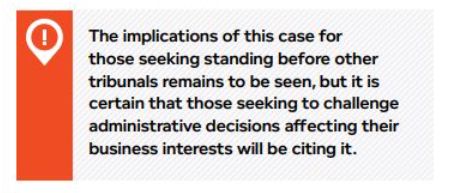- with readers working within the Utilities industries
Alberta
NORMTEK RADIATION SERVICES LTD V. ALBERTA ENVIRONMENTAL APPEAL BOARD, 2020 ABCA 456
Whether a party has standing before a tribunal is not commonly litigated, however, the question of standing can be of critical importance to parties appearing before administrative tribunals such as the Alberta Environmental Appeal Board.
In this case, the appellant, Normtek, opposed an approval to amend a landfill approval to allow the disposal of concentrated, naturally occurring radioactive material ("NORM"), which had been granted by the designated director of approvals (the "Director"). Normtek, which is in the business of disposing of NORM, did not oppose the approval outright, but only certain conditions of the approval, which allowed for high level radioactive waste to be dumped near the surface.
After having its statement of concern rejected by the Director, who claimed Normtek was not directly affected by the approval, the company attempted to appeal the Director's decision to grant the permit to the Environmental Appeals Board (the "Board"). As with statements of concern submitted to the Director, the Environmental Protection and Enhancement Act (the "Act"), requires the appellant to be "directly affected" by the Director's decision. Normtek submitted that it was directly affected by the decision because the approval to allow dumping of high level waste near the surface (rather than in a deep geological formation), would affect its business and its nascent industry, which abided by national and international standards that Normtek stated were not being upheld. The Board denied standing on several grounds, including: (i) that Normtek's concerns were primarily economic; and (ii) that "[f]or the Appellant to be directly affected, they need to demonstrate on a prima facie basis either they will be impacted from radiation coming from the Landfill or that their use of a natural resource will be impacted by radiation coming from the Landfill." Normtek's application for judicial review of the Board's decision was dismissed.
The Alberta Court of Appeal considered the narrow interpretation of "directly affected" adopted by the Board to be unreasonable and unsupported by the Act. The Court noted that the economic effects of an approval may be enough to ground standing, and addressed other problems with the Board's decision, including failing to consider relevant evidence and applying an overly strict standard for the appellant to meet. Although the Court seems to advocate a lenient approach to the standing issue, it is significant that the Board in this case does not make substantive decisions, but rather reports information to the responsible Minister and makes nonbinding recommendations. The gatekeeping role of the Board means that the concerns of an appellant who is denied standing will never even come to the attention of the ultimate decision maker. The Court remitted the issue of Normtek's standing back to the Board to be decided "having regard to the provisions of the Act and the evidence relevant to the determination to be made."

ECOJUSTICE CANADA SOCIETY V. ALBERTA JUDICIAL REVIEW, 2020 ABQB 364 AND 2020 ABQB 736
In 2019, the Government of Alberta launched a public inquiry under the Public Inquiries Act to investigate anti-Alberta energy campaigns supported by foreign organizations, and appointed a Commissioner. Ecojustice brought an application for judicial review seeking to stop the public inquiry on three grounds. That application was set to be heard in April 2020, but had to be adjourned sine die because of the emerging COVID-19 pandemic. A decision on the underlying application is expected in 2021.
Two interlocutory applications were heard in 2020 that will be of interest to those following the case. In the first, an "industry consortium" of organizations and one individual sought leave of the Court to jointly intervene in order to speak to two of the three grounds upon which Ecojustice brought its application. All were pro-industry, and the individual intervenor was outspoken about those who opposed Alberta oil and gas. Ecojustice opposed the application for intervenor status, and although the Court agreed with Ecojustice that the arguments proposed to be raised were speculative, it ultimately found that the consortium's industry perspective and direct interest in the matter weighed in favour of allowing it to intervene on one of the two matters to which it applied. Unsurprisingly, the Court cautioned the intervenors against inflammatory political rhetoric.
In the second interlocutory application, Ecojustice sought an injunction to stay the inquiry until the judicial review application could be heard, citing numerous procedural grounds for its application. The Court applied the test from RJR-MacDonald Inc. v. Canada (Attorney General), and found that there was no clear evidence of irreparable harm to Ecojustice's reputation that would ensue if the injunction was not granted (as Ecojustice alleged), and the application therefore failed.
ALEXIS V. ALBERTA (ENVIRONMENT AND PARKS), 2020 ABCA 188
In another post-Vavilov decision, the Alberta Court of Appeal considered a situation where an administrative decision maker was not required to provide reasons for her decision, and did not.
In Alexis v. Alberta (Environment and Parks), the Applicant asked a Director under the Environmental Protection and Enhancement Act (the "Act") to order an environmental impact assessment report after the Director had declined to do so. The Applicant took the position that this was required under the terms of the Act. However, the Director replied that under the circumstances it was a discretionary matter, and that no order would be made. An application for judicial review at the Court of Queen's Bench was dismissed.
On appeal, the parties agreed that the standard of review applicable to the Director's decision was reasonableness. The requirement to provide reasons was not in dispute, but given that no reasons were provided, the Court undertook its own statutory interpretation to resolve the matter. The majority held that the Director's decision was irrational and unreasonable. Given that there was only one reasonable solution, it made no sense to remit the matter back to the Director, so the Court instructed the Director to order that an environmental impact assessment report be submitted.
The most interesting aspect of this decision is the Court's determination that there was only one reasonable outcome, and not returning the matter back to the original decision maker for an ultimate decision. Historically, courts have rarely taken that approach. Indeed, in this case, the partially dissenting judge would have remitted the matter back to the Director.
This case shows that deference has limits. If it can be credibly argued that there is only one reasonable result, and particularly if a court does not have reasons for the decision it being tasked with reviewing, the court may be willing to substitute its own interpretation, even in a reasonableness review. This can be a powerful remedy.
Ontario
ROGERS COMMUNICATIONS CANADA INC. V. ONTARIO ENERGY BOARD, 2020 ONSC 6549
Any organization subject to Ontario Energy Board ("OEB") regulation should take heed of a November 2020 court decision that affirms the OEB's broad scope to determine its own procedures.
The challenge was made by a group of telecom companies (the "Carriers") who are charged standard rates for attaching their cables to electricity poles in Ontario. The Carriers sought to quash a report in which the OEB increased the default charge from $22.35 per pole per year, established in 2005, to $43.63.
Updating the fee was part of a "comprehensive review" by the OEB, in which it received input from a limited stakeholder group, issued a draft report for comment, and subsequently issued a final report.
The Carriers challenged the report before the Ontario Divisional Court. They argued they had been caught off guard by the fee increase and they had expected that a full hearing would take place before any such determination.
On this basis, the Carriers argued that the OEB's procedure was unfair.
The Court dismissed the Carriers' appeal. Although the court acknowledged that the Carriers "may not have expected" that the policy review would have resulted in a new default charge, the OEB was nevertheless on solid ground.
The Court gave the OEB a wide berth in managing the policy review and its outcomes, stating that "[d]eference applies to the decision of the [OEB] as to the process it adopted to conduct the policy review."
HYDRO ONE NETWORKS INC. V. ONTARIO ENERGY BOARD, 2020 ONSC 4331
After a years-long dispute with the OEB regarding the allocation of substantial tax savings, Hydro One has scored a notable victory at the Ontario Divisional Court.
The ruling handed down in July 2020 effectively means that the benefit of $2.6 billion in tax savings will flow to its shareholders, rather than to ratepayers.
In 2015, Hydro One underwent an initial public offering, at which time the government of Ontario sold its majority stake in the company. This caused Hydro One to lose certain tax privileges and resulted in a $2.25 billion "departure tax" bill, which the company funded with a pre-IPO stock sale.
The change also allowed Hydro One to increase the value of certain assets by $9.7 billion. This in turn allowed for higher tax deductions, which resulted in savings that the utility planned to pass on to its shareholders. The OEB disagreed and determined that 38% of the savings should go to ratepayers (in the form of lower electricity rates), but failed to explain what methodology it was relying on in making this determination.
Hydro One appealed to the Ontario Divisional Court, arguing that since the OEB found that the departure tax was a real cost to Hydro One, the only reasonable decision possible was that the utility's shareholders were entitled to all of the tax savings.
The Court allowed the appeal and agreed with Hydro One, stating that the OEB applied the wrong legal test and that its decision "lacks an internally coherent and rational chain of analysis." The court applied a "correctness" standard, which means little or no deference given to the OEB in this particular instance. The Court confirmed that the new approach arising from the Supreme Court of Canada's Vavilov decision applies to statutory appeals from the OEB, effectively making it easier to challenge the OEB where a right of appeal exists. However, the Court in this case noted it would still have found against the OEB even if the more deferential "reasonableness" standard had applied.
The matter was ordered to be brought back before the OEB to make "an appropriate order varying the tax savings allocation."
Although regulatory bodies like the OEB are often entitled to significant deference (making their decisions difficult to overturn), this case serves as an example of where a poorly reasoned regulatory decision combined with a statutory right of appeal worked strongly in favour of the utility.
McCarthy Tétrault represented Hydro One before the OEB and the Divisional Court.
NATION RISE WIND FARM LIMITED PARTNERSHIP V. MINISTER OF THE ENVIRONMENT, CONSERVATION AND PARKS, 2020 ONSC 2984
A decision from the Ontario Divisional Court is offering some welcome clarity to organizations concerned about risk and uncertainty arising from changes in government and public policy.
In May 2020, the Nation Rise saga met a critical juncture when the Court found that the Minister of Environment, Conservation and Parks' revocation of the Renewable Energy Approval ("REA") for the Nation Rise Wind Farm was both unreasonable and failed to meet procedural fairness requirements.
The Minister's decision to revoke the Nation Rise REA landed in December 2019, more than a year after the project had been approved and when the 100 MW wind farm was already well under construction.
The decision was based on submissions from Nation Rise and from an opposing community group, which had appealed from a decision of the Environmental Review Tribunal ("ERT") upholding the REA.
Although the Minister found the ERT decision to be "thorough and well reasoned", he decided that the wind farm could cause "serious and irreversible" harm to bat maternity colonies. Notably, such colonies had not been at issue before the ERT and were not raised by either party on appeal to the Minister.
Nation Rise appealed to the Divisional Court.
The Court sided with Nation Rise, finding that the Minister had unreasonably concluded that he had authority to add new issues - namely the issue of bat maternity colonies - on the appeal. He had applied the wrong legal test by using the precautionary approach which differed from the legislative requirement.
Moreover, the procedure adopted by the Minister was unfair in that he failed to notify the parties that the issue of bat maternity colonies would be an issue on appeal, and failed to provide a separate hearing with respect to the appropriate remedy after a decision was issued.
The new milestone date is June 17, 2021.
GRASSHOPPER SOLAR CORPORATION V. INDEPENDENT ELECTRICITY SYSTEM OPERATOR, 2020 ONCA 499
If you are in the business of developing or financing power projects in Ontario, a recent Court of Appeal decision may change the way you look at contractual completion dates, as well as your ability to rely on the statements of a counterparty.
Grasshopper Solar entered into a series of standard form feed-in tariff ("FIT") contracts with the IESO in August 2016. The contract required Grasshopper to achieve "Commercial Operation" of the facility by a specified date (the "Milestone Date"). While it provided in s. 2.5(a) that "time [was] of the essence" for this obligation, it addressed termination rights separately under the detailed provisions of Article 9. Section 9.1( j) permitted the IESO to terminate if Commercial Operation was delayed, but only if Grasshopper did not achieve Commercial Operation within 18 months after the Milestone Date. Section 9.1(b) also permitted the IESO to terminate for any "material" default, but it was subject to prior expiry of a 15 to 30 day cure period, and contained a carve-out for events of default that were already addressed separately in Article 9, as under s. 9.1( j).
At the time of the FIT contract, there was an existing IESO bulletin from 2013 (the "Bulletin") stating that if a FIT contract holder could not achieve Commercial Operation by the Milestone Date, the IESO would not exercise its purported termination right in s. 9.1(b). The Bulletin also contained technical qualifying language stating that it did not constitute a waiver and should not be relied on by suppliers.
In March 2019 - 2.5 years into its FIT contract - Grasshopper received a letter from IESO informing Grasshopper that the IESO was retracting the Bulletin and that the FIT contracts would be terminated under s. 9.1(b) if Grasshopper did not achieve Commercial Operation by the Milestone Date, which by then was only 6 months away, a deadline that was virtually impossible to meet. The IESO's change in position came 9 months after the election of the Progressive Conservative Party in Ontario, which had campaigned on a platform that was hostile to the previous Liberal government's clean energy program.
Grasshopper applied to the Ontario Superior Court for a declaration that the IESO could not terminate for Grasshopper's failure to achieve Commercial Operation by the Milestone Date unless Commercial Operation was still not achieved 18 months after the Milestone Date. In essence, it argued the IESO could not exercise its general termination right in s. 9.1(b), because the failure to achieve Commercial Operation by the Milestone Date was an event of default already dealt with separately in s. 9.1( j), where it was subject to an 18-month cure period rather than the 15 to 30 day cure period in s. 9.1(b). In addition, Grasshopper argued that the IESO was estopped from terminating the FIT contracts on this basis given the Bulletin and the IESO's lengthy pattern of conduct in applying it, which created a mutual assumption that that Grasshopper relied upon to its detriment.
Grasshopper was unsuccessful before the Ontario Superior Court, as well as before the Ontario Court of Appeal. The courts held that because s. 2.5(a) of the FIT contract said that time was of the essence in respect of Grasshopper's obligation to achieve Commercial Operation by the Milestone Date, the failure to do so was necessarily an event of default that engaged the IESO's termination right in s. 9.1(b), regardless of whether it was dealt with separately in s. 9.1( j). The courts also found that there was no mutual assumption that the IESO would not exercise its termination right in s. 9.1(b) for the failure to achieve Commercial Operation by the Milestone Date, so as give rise to estoppel, because the qualifying language in the Bulletin left the IESO free to change its position and the March 2019 letter was reasonable notice of its intent to do so. The courts were not swayed by the serious economic consequences to be faced by Grasshopper by virtue of the IESO's change in position.
McCarthy Tétrault represented Grasshopper before the Court of Appeal. There is presently an application for leave to appeal pending before the Supreme Court of Canada.
Quebec
RIVARD C. ÉOLIENNES DE L'ÉRABLE, 2020 QCCS 601
This is Canada's first ever class action decision on the merits involving a wind project developer and its wind farm. It confirms that the installation of wind turbines in a settled area does not per se give rise to liability for damages resulting from abnormal neighborhood disturbances.
In 2008, Hydro-Québec selected the wind power project proposed by Enerfin (now Éoliennes de l'Érable) to install 50 wind turbines, for a total capacity of 100 MW in rural areas situated in the Centre-du-Québec region.
The class action was instituted on behalf of the residents of that area who were claiming damages for the annoyances associated with the construction and the operation of the wind farm based on the Civil Code of Québec, which provides for a "right to nuisance", as long as it does not exceed the threshold of tolerance required in a given context. Only annoyances with a certain level of recurrence and gravity will be considered as abnormal within the meaning of that article.
The Superior Court first rejected the class members' claim that the alleged annoyances of truck traffic, schedules of work, road closures, detours, use of engine brakes, dust and noise constituted abnormal neighborhood annoyances during the construction phase. The Court noted that the defendant had taken a number of measures to limit the annoyances and to maintain effective collaboration with the municipality.
the decree approving the project, thus rejecting the members' claim pertaining to the operation phase. Finally, the Court held that the members could not be compensated for the loss of visual appearance due to the presence of the wind turbines. "
The class members filed an appeal in September 2020, and the appeal is expected to be heard in 2021.
ATTORNEY GENERAL OF QUÉBEC V. IMTT-QUÉBEC INC., 2019 QCCA 1598
In April 2020, the Supreme Court of Canada dismissed an application by the Attorney General of Quebec to appeal a judgment rendered by the Québec Court of Appeal in September 2019. The decision may be of interest to any energy company carrying out federally-regulated activities and seeking environmental permits in any province, as it confirms the inapplicability of certain provincial environmental requirements with respect to such activities.
IMTT-Québec Inc. ("IMTT") is a federally-incorporated company that handles and stores bulk liquid products (including petroleum, heating oil, jet fuel, oils and lubricants, ethanol, methanol and biodiesel) in large tanks on federal property that it leases from the Québec Port Authority. IMTT's customers rent these tanks to transport the various products delivered to the Port of Québec (mainly by ship). In 2006, IMTT decided not to seek provincial authorization when it began planning new tank construction projects to increase capacity, claiming it was a company under federal jurisdiction not subject to the Québec Environment Quality Act ("EQA"), and rather sought and obtained authorization from the Québec Port Authority and federal authorities. IMTT and the Québec Port Authority sought a declaration that the EQA's authorization scheme was either inapplicable or inoperative with regard to IMTT's federal activities within the Port of Québec.
The Court of Appeal also upheld the trial judge's conclusion that the EQA's environmental authorization scheme was constitutionally inoperative with respect to IMTT's activities pursuant to the doctrine of federal paramountcy, which applies where there is an operational conflict between a valid provincial law and a valid federal law, or where the provincial statute frustrates the purpose of the federal legislation.
McCarthy Tétrault successfully represented the Québec Port Authority and IMTT in this matter.
HYDRO-QUÉBEC V. MATTA, 2020 SCC 37
In this unanimous decision, the Supreme Court of Canada found that nothing prevented Hydro-Québec from building a new electricity line to be routed in part through private lots on which Hydro Québec already had servitudes (known as "easements" outside of Quebec) established for another electrical transmission line.
In 2015, Hydro-Québec received authorization to construct an electrical transmission line between a transformer substation in Saguenay-Lac-St-Jean and another one in Montréal. Hydro-Québec realized that it would be easier to run the line through a corridor where it already had servitudes that had been established in the 1970s for a distinct transmission line. Hydro-Québec claimed that these servitudes authorized it to route up to three electrical transmission lines but the current owners of the lots submitted that the rights arising from the servitudes were limited to the existing line only and denied Hydro Québec's employees access to their lots.
As there was no mention of any restrictions regarding the origin or the destination of the electricity, the Court concluded that the servitudes were not limited to the existing line. The Court added that the servitudes concerned the lines crossing the servient land, not the substations located at either end of those lines, thus nothing in the words of the agreements explicitly or implicitly prevented Hydro-Québec from redirecting one of its lines toward another substation.
RESOLUTE FP CANADA INC. V. HYDRO-QUÉBEC, 2020 SCC 43
In 1926, the corporate predecessor of Resolute FP Canada Inc. ("Resolute"), a forest products company, and the Gatineau Power Company ("Gatineau Power"), a private electricity producer, signed a contract for the supply of electric power which provided that Resolute would accept any increases in the price of electricity that might result from future increases in taxes or charges levied by the provincial or federal government on electrical energy generated from water power. In the early 1960s, during the phase of the nationalization of electricity, Gatineau Power became a wholly owned subsidiary of Hydro-Québec. In 1965, Hydro-Québec entered into a contract with Gatineau Power to unify Gatineau Power's management and operations and to provide for the sale of all of Gatineau Power's movable assets to Hydro-Québec and the lease of all of the Gatineau Power's real estate for a term of 25 years to Hydro-Québec.
Starting in 2007, Hydro-Québec had two new levies imposed on it under provincial legislation. Relying on the price adjustment clause in the 1926 contract, Hydro-Québec sent Resolute an electricity bill for over $3 million in 2011, claiming from Resolute an increase in the price of electricity that resulted from the levies it paid to the Québec government. Resolute paid this bill under protest and asked the Superior Court to declare that it did not owe the amount being claimed from it to either Hydro-Québec or Gatineau Power.
The majority therefore rejected Resolute's argument that the 1965 contract merely made Hydro-Québec a mandatary of Gatineau Power for purposes of managing the 1926 contract. Because the two levies at issue were a "tax or charge" on electricity generated from water power within the meaning of the 1926 contract, the majority concluded that they were therefore payable by Resolute to Hydro-Québec under that agreement.
Download the report on Key Developments in 2020, Trends to Watch for in 2021
To view the original article click here
The content of this article is intended to provide a general guide to the subject matter. Specialist advice should be sought about your specific circumstances.







